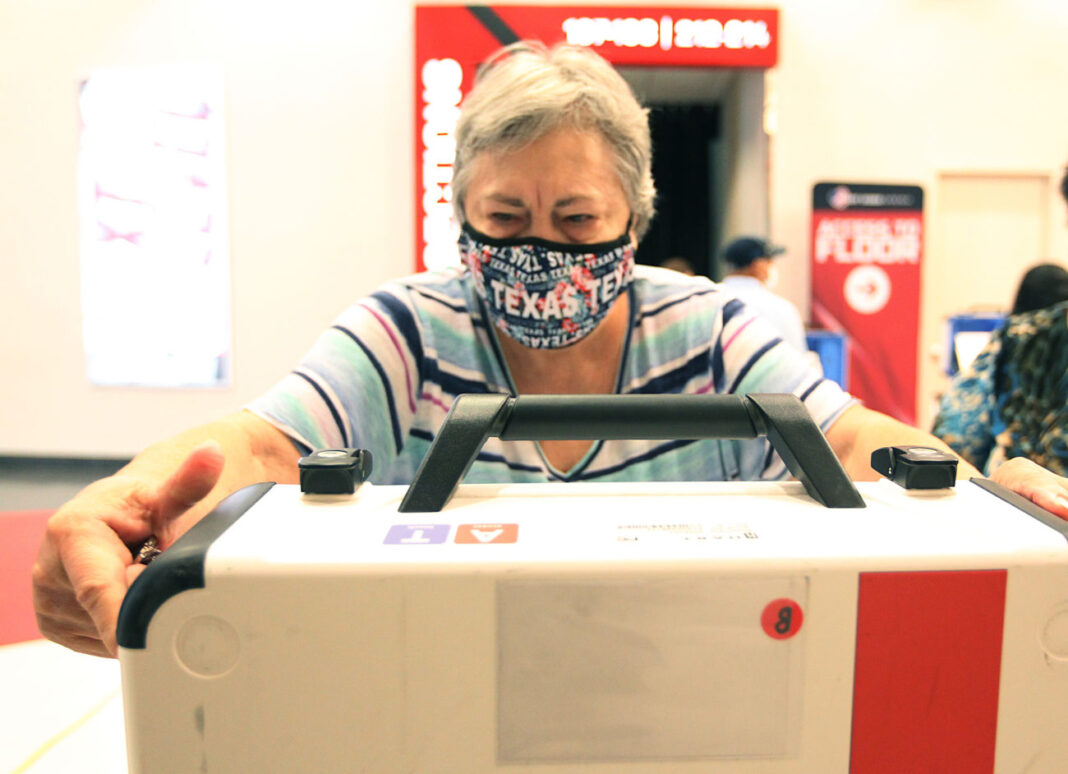Faced with new statewide requirements for election equipment, Hidalgo County commissioners approved the emergency appropriation of $2.6 million for the modification of their current voting machines — but they still need to authorize another $1.6 million to completely meet the requirements.
The commissioners agreed to fund the estimated $2,648,740 needed to convert the county’s machines into auditable voting machines with paper trails in order to be in compliance with Senate Bill 598.
The bill, which Gov. Greg Abbott signed into law in June, and went into effect on Sept. 1, requires all counties in the state to have auditable voting machines.
It states that no later than 24 hours after all ballots have been counted in an election, the general custodian of election records shall conduct a risk-limiting audit for a selected statewide race or measure. The secretary of state shall select, in accordance with rules adopted by the secretary, the precincts to be counted and the office or proposition to be counted.
Currently, Hidalgo County has electronic voting machines which were required so that the county could implement countywide voting, a method that allows voters to cast a ballot at any election site in the county during early voting and on election day.
The Countywide Polling Place Program required that a participating county exclusively used direct electronic voting systems at all polling places. The equipment, purchased in 2016, cost the county nearly $6 million.
“The law back then said in order to be a countywide county, which is what we are now where you can vote anywhere during early vote and election day, you must have electronic voting,” said Yvonne Ramon, the Hidalgo County elections administrator. “So the law mandated that we buy this equipment. Now the law is mandating that we change the equipment.”
Because of that mandate, the county is expecting to spend $2.6 million to convert their equipment and another estimated $1.6 million for related expenses.
Ramon pointed out, however, that the county has the opportunity to be reimbursed for 100% of the conversion costs.
S.B. 598 states that an authority that purchased a non-auditable voting system after Sept. 1, 2014 and before Sept. 1, 2021 is able to use federal funds or available state funding to convert their equipment into an auditable voting system.
If the equipment is converted before the election on Nov. 8, 2022, the authority is eligible to have 100% of those costs reimbursed.
If they miss that deadline, the authority could still be eligible to have 50% of those costs reimbursed if the conversion is done by the election on Nov. 3, 2026.
“So that gives us about a year to change our equipment in order to get 100% back,” Ramon said, clarifying the reimbursement would only be for the $2.6 million. “The county would still be responsible for about $1.6 million because it’s not just the conversion, now we need supplies, we need equipment, we need controllers, we need other things.”
That additional $1,670,668 will pay for 250 scanners that will actually tabulate the votes. Each will cost $6,100.
Other extra costs include 250 ballot boxes, equipment for poll workers, training, licenses and support.
As for the $2.6 million for the conversion itself, Ramon said it was still unclear if the county would actually be fully reimbursed for those funds even if they completed the conversion before the November 2022 election.
She noted that about 43 to 44 counties qualify for the reimbursement, with Hidalgo County being the largest. For those, Ramon said the Texas Secretary of State’s office already has $34 million budgeted.
“Until the Secretary of State decides how much each county will receive, will we actually know — if we are in place by November 2022 — if we would get 100% back of the $2.6 (million),” Ramon said.
Still, she said she wants the machines to be converted immediately in hopes that they’ll be ready by the Texas Primary Elections next year.
The machines will be sent to the vendor, Hart InterCivic, a company based in Austin.
The county will keep about 400-450 voting machines for the elections in November but will begin to send the ones they won’t be using.
“We’ll get boxes, we’ll ship equipment, they’ll send it back and it’ll be a back and forth until we finish with all of our equipment,” Ramon explained.
When the changes are done and the machines are ready for use, voters can expect some significant changes to how they cast a ballot.
Voters will have to submit a piece of paper into a machine where they will electronically mark their ballot like they do now. When they’re done, the piece of paper will come back out of the machine and voters will have to walk that paper over to a scanner.
“We just need to make sure that our community is well trained so that we don’t have people walking away with a paper ballot,” Ramon said. “Now, it’s got to be scanned into a tabulator, no longer do you just hit vote on the electronic machine and your vote is cast.
“Now you will have that paper trail in a ballot box,” she said.





